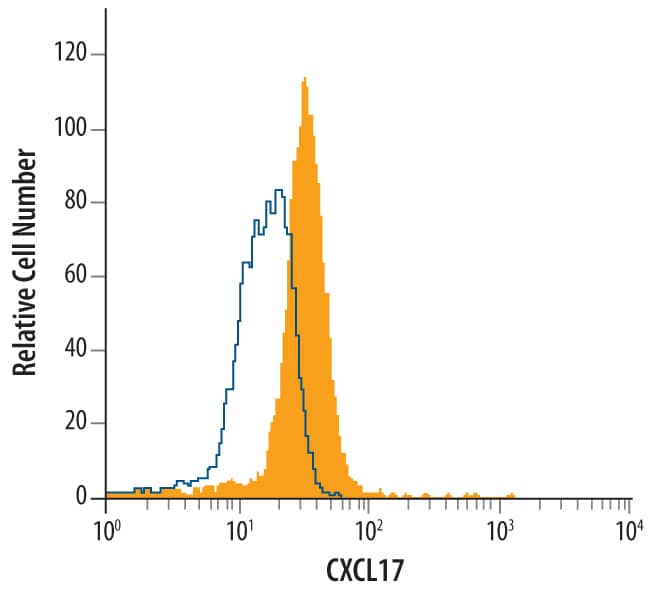Human CXCL17/VCC-1 Antibody
R&D Systems, part of Bio-Techne | Catalog # MAB4207


Key Product Details
Species Reactivity
Validated:
Cited:
Applications
Validated:
Cited:
Label
Antibody Source
Product Specifications
Immunogen
Leu24-Leu119
Accession # Q6UXB2
Specificity
Clonality
Host
Isotype
Scientific Data Images for Human CXCL17/VCC-1 Antibody
Detection of CXCL17/VCC-1 in A549 Human Cell Line by Flow Cytometry.
A549 human lung carcinoma cell line was stained with Mouse Anti-Human CXCL17/VCC-1 Monoclonal Antibody (Catalog # MAB4207, filled histogram) or isotype control antibody (Catalog # MAB0041, open histogram), followed by Allophycocyanin-conjugated Anti-Mouse IgG F(ab')2Secondary Antibody (Catalog # F0101B). To facilitate intracellular staining, cells were fixed with paraformaldehyde and permeabilized with saponin.CXCL17/VCC‑1 in A549 Human Cell Line.
CXCL17/VCC-1 was detected in immersion fixed A549 human lung carcinoma cell line using Mouse Anti-Human CXCL17/VCC-1 Monoclonal Antibody (Catalog # MAB4207) at 10 µg/mL for 3 hours at room temperature. Cells were stained using the NorthernLights™ 557-conjugated Anti-Mouse IgG Secondary Antibody (red; Catalog # NL007) and counterstained with DAPI(blue). Specific staining was localized to cytoplasm. View our protocol for Fluorescent ICC Staining of Cells on Coverslips.Applications for Human CXCL17/VCC-1 Antibody
CyTOF-ready
Immunocytochemistry
Sample: Immersion fixed A549 human lung carcinoma cell line
Intracellular Staining by Flow Cytometry
Sample: A549 human lung carcinoma cell line fixed with paraformaldehyde and permeabilized with saponin
Western Blot
Sample: Recombinant Human CXCL17 (Catalog # 4207-DM)
Reviewed Applications
Read 1 review rated 5 using MAB4207 in the following applications:
Formulation, Preparation, and Storage
Purification
Reconstitution
Formulation
Shipping
Stability & Storage
- 12 months from date of receipt, -20 to -70 °C as supplied.
- 1 month, 2 to 8 °C under sterile conditions after reconstitution.
- 6 months, -20 to -70 °C under sterile conditions after reconstitution.
Background: CXCL17/VCC-1
CXCL17, also known as dendritic cell and monocyte chemokine-like protein (DMC) and VEGF-correlated chemokine-1 (VCC-1), is a secreted molecule with a size and predicted three-dimensional folding pattern similar to that of chemokines CXCL8/IL-8 and CXCL14/BRAK (1, 2). It has no predicted N-glycosylation site. Cleavage of a 23 amino acid (aa) signal sequence yields the mature 96 aa human CXCL17. CXCL17 is constitutively produced by airway and intestinal epithelium (1). It induces the chemotaxis of quiescent, but not LPS-activated peripheral blood monocytes and dendritic cells (1). CXCL17 expression is increased in endothelial cells when they are induced to form tubes in vitro (2). Transgenic overexpression in NIH3T3 cells causes upregulation of proteins such as VEGF and FGF basic, and increases cell growth rate and tumorigenicity (2). CXCL17, plus two other chemokines that play roles in angiogenesis, CXCL1/GRO and CXCL8/IL-8, show a correlated expression pattern with VEGF in primary lung, breast and esophageal tumors (2). CXCL17 is, therefore, suggested to play a role in tumor angiogenesis. Mature human CXCL17 shares 73%, 71% and 64% amino acid sequence identity with bovine, mouse and rat CXCL17, respectively.
References
- Pisabarro, M.T. et al. (2006) J. Immunol. 176:2069.
- Weinstein, E.J. et al. (2006) Biochem. Biophys. Res. Commun. 350:74.
Alternate Names
Gene Symbol
UniProt
Additional CXCL17/VCC-1 Products
Product Documents for Human CXCL17/VCC-1 Antibody
Product Specific Notices for Human CXCL17/VCC-1 Antibody
For research use only
